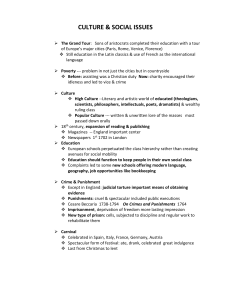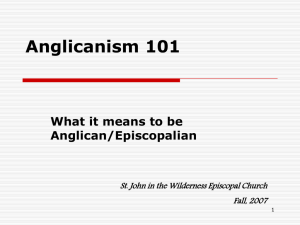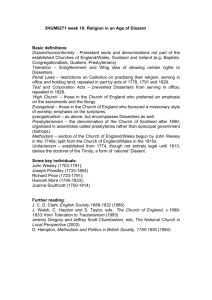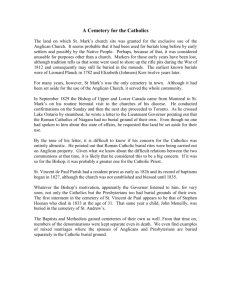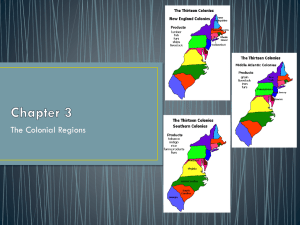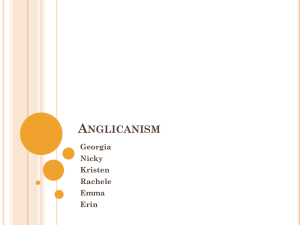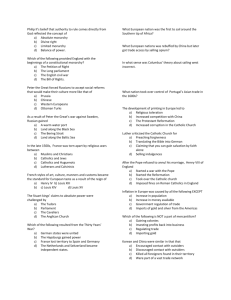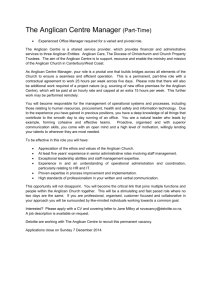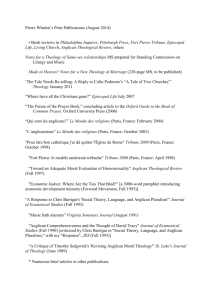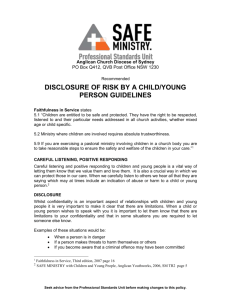Synoptic Revision - Religion - Penketh
advertisement
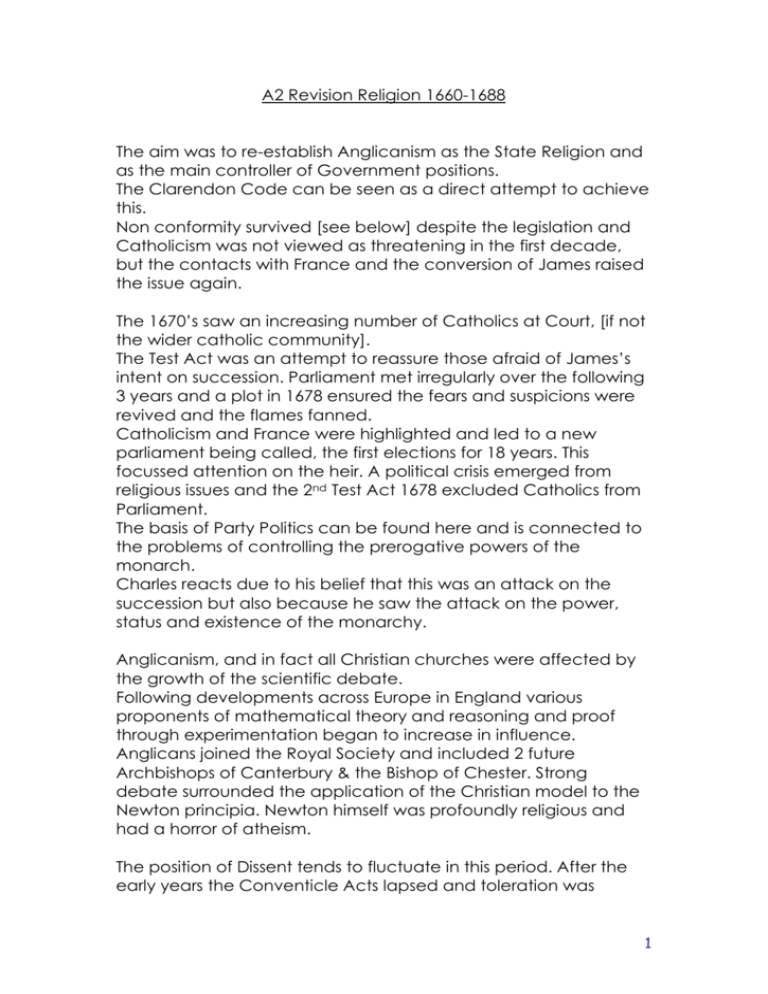
A2 Revision Religion 1660-1688 The aim was to re-establish Anglicanism as the State Religion and as the main controller of Government positions. The Clarendon Code can be seen as a direct attempt to achieve this. Non conformity survived [see below] despite the legislation and Catholicism was not viewed as threatening in the first decade, but the contacts with France and the conversion of James raised the issue again. The 1670’s saw an increasing number of Catholics at Court, [if not the wider catholic community]. The Test Act was an attempt to reassure those afraid of James’s intent on succession. Parliament met irregularly over the following 3 years and a plot in 1678 ensured the fears and suspicions were revived and the flames fanned. Catholicism and France were highlighted and led to a new parliament being called, the first elections for 18 years. This focussed attention on the heir. A political crisis emerged from religious issues and the 2nd Test Act 1678 excluded Catholics from Parliament. The basis of Party Politics can be found here and is connected to the problems of controlling the prerogative powers of the monarch. Charles reacts due to his belief that this was an attack on the succession but also because he saw the attack on the power, status and existence of the monarchy. Anglicanism, and in fact all Christian churches were affected by the growth of the scientific debate. Following developments across Europe in England various proponents of mathematical theory and reasoning and proof through experimentation began to increase in influence. Anglicans joined the Royal Society and included 2 future Archbishops of Canterbury & the Bishop of Chester. Strong debate surrounded the application of the Christian model to the Newton principia. Newton himself was profoundly religious and had a horror of atheism. The position of Dissent tends to fluctuate in this period. After the early years the Conventicle Acts lapsed and toleration was 1 practised. Then during May 1670 – April 1671 repression increased but was followed by a more tolerant attitude encouraging the Declaration of Indulgence 1672 which was received with demands for increased repression until the Popish Plot and Exclusion heralded a more lenient attitude before the repression of the period 1681-85. Dissenters found ways to cope with the repression of these times. Dissenting Academies were formed to counter the restrictions of Oxford & Cambridge. Preachers trained in Holland and 5 main sects emerged. [Quakers, Presbyterians, Baptists [General & Particular] and Independents. The Catholic community, though small was constant c60, 000 [1% of the population]. There was a fair representation among the governing class and politically conformed. They obeyed the law and enjoyed practical toleration. During 1679-80 only 1 Peer and no landed gentry was convicted of High Treason. The position of the Duke of York and Louis XIV was the main threat and Anglican fears post the Revocation of the Edict of Nantes led to an increase in written debate. Anglicanism survived due to a commitment of its leaders to have an ordered and disciplined church on the Laudian model. 2 Protestant Nonconformity Restoration Settlement was an Anglican backlash. 1662 non-conformists were legally defined by the Act of Uniformity. If the Book of Common Prayer was not followed the church was deemed illegal. Non conformity could result in confiscation of gods or even death. The Quakers were specifically singled out in 1662. What was a Dissenter? Those who refused to attend Anglican services. They were totally separate from the Church of England and had no wish to be included in it. They included members of a variety of sects. What was a Non-Conformist? They also refused to attend Anglican service but held basically the same beliefs as Anglicans. They rejected the Act of Uniformity. Clergy might refuse ordination from a Bishop, may not assent to the Book of Common Prayer as it prevented extempore prayer, and may refuse to accept church government by Bishops. Many clergy still attended Anglican service but also held non-conformist meetings. Ordinary churchgoers [Laity] may attend Anglican Communion once a month. As the reign progressed a new generation developed. They had no wish to incorporated into the C of E. Their case was strengthened after the Dec. of Indulgence 1672. Numbers are based on Bishop Compton’s census 1676 which suggests 5% of the 3 population were full non-conformists. This may be an underestimate as definition is difficult. Debate over Comprehension and Toleration. The authorities moved away from inclusion. This caused problems as Local Government officials didn’t want to persecute or prosecute their neighbours. Some wished to make the Church more comprehensive so they could more easily isolate dissenters. Others wished to have a measure of toleration which would isolate those seen as a threat to political or social order. Internal splits were seen as more damaging than having an identifiable group outside the Church. The issue is raised throughout Charles II’s reign This followed the Declaration of 1662 which seemed to use the prerogative to dispense groups from the law and appeared to crave indulgence for Catholics and Dissenters. The Conventicle Act 1670 gave Charles the impression he could dispense individuals from the law, but this was dispelled following the persecution which followed in London. 1672 2nd Dec of Indulgence applied to Catholics and Dissenters 1673 Parliament forced the King to withdraw this. Again the problem also concerned prerogative power. The Test Act showed attitudes towards Catholics. By the time of Exclusion attempts at a Toleration and Comprehension \bill failed to pass the Commons. Intense anti Catholicism following the Popish Plot led some to expect an attempt to unite Protestants against Catholicism but this was not acceptable to Parliament. 4 With the ‘Tory reaction’ intolerant policies were enforced and the cause of comprehension lost momentum. Indulgence seemed a more attractive option. James II James failed to get Dissenter support to repeal the Test and Corporation Acts Dissenters associated Catholicism with absolutism and had more in common with Anglicans than Catholics They were divided among themselves making a united policy difficult They did not trust James Archbishop Sancroft set up a committee to investigate changes in the prayer book to give it more appeal to dissenters They were alarmed by James’s policy of trying to influence MP’s and remodel corporations to get a pliable parliament. 2nd Dec of Indulgence April 1688 placed the Anglican clergy in a difficult position and led to the Seven Bishop protest. The birth of a child was seen as a Catholic plot and led to unity against a Catholic dynasty and the eventual removal of James. 5
